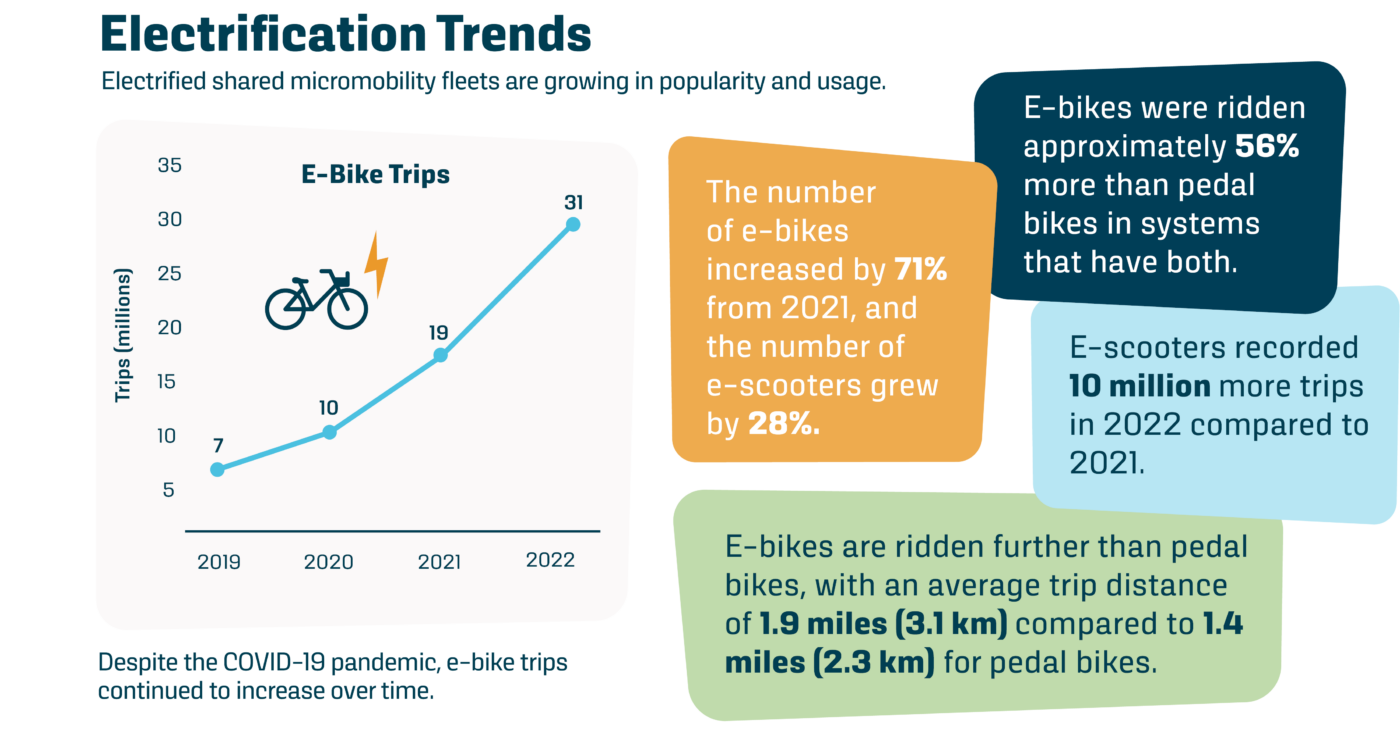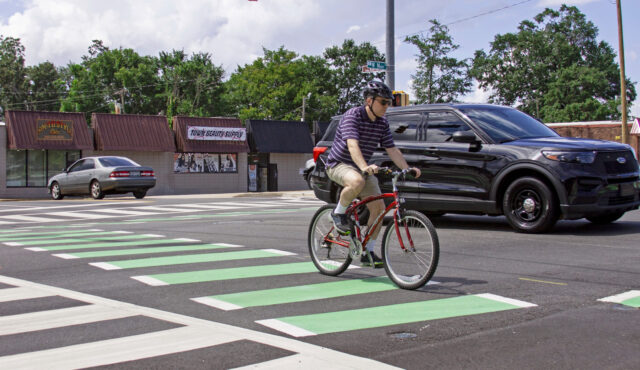Electric bicycles (e-bikes) are experiencing a global growth spurt that is reshaping mobility and that has the potential to be transformational for many communities. Nearly half of Americans say they are interested in buying an e-bike in the next five years, and e-bike sales outpaced that of electric vehicles in 2022. E-bikes are encouraging new, novice, or tentative riders to get around on two wheels, leading many to believe that they could play a massive role in helping cities meet their climate, mobility, and equity goals.
As a company committed to helping communities transition toward more equitable and sustainable modes of travel, we actively embrace the rise of e-bikes. Of course, as with all things new or unfamiliar, e-bikes can bring challenges along with their immense opportunities. By understanding those challenges, we can work together to plan wisely and develop solutions.
Drawing from our work over the past decade+ on e-bike policy, safety, and incentives, we’ve distilled a list of 8 recommendations for wisely and proactively including e-bikes in transportation planning and design. (And good news: these tips are also applicable to e-scooters and other forms of micromobility.)
1. Explicitly Address E-Bikes in Active Transportation Plans
Conventional active transportation plans (ATPs) only address walking and biking. E-bikes — alongside scooters and a wide range of similar lightweight, low-speed devices — have unique needs when it comes to policy, education, safety, communications and outreach, charging/battery safety, parking/storage, and facility design. Bike plans and ATPs should be intentional in their focus on these unique travel modes. For a great example, check out the City of Pittsburgh’s Bike(+) Master Plan or the in-development Columbus Bike Plus Plan.
2. Know the rules that govern e-bikes in your community
There is a lot of variation in which types of bikes are allowed to ride where. Some states still have outdated laws that were originally intended for mopeds and motorbikes. The first step toward seizing the potential benefits of e-bikes is to make sure that: a) e-bikes are regulated like bicycles, i.e., the same rules of the road apply to both, and b) e-bikes are distinguished in state law from mopeds or combustion-engine scooters, including via a maximum speed at which the bike provides e-assist.
Also, be wary of e-bike (and e-scooter) bans on trails or in certain parts of town. New travel modes can bring new challenges, and some places are reacting to those challenges with e-bike bans, onerous licensing requirements, or other policies that make e-biking inconvenient or infeasible. In cities with goals related to mode shift, climate, or equitable access to affordable transportation options, we need to carefully weigh the cost:benefit of policies that make it harder to “go green,” and look for other solutions to the challenges that arise.
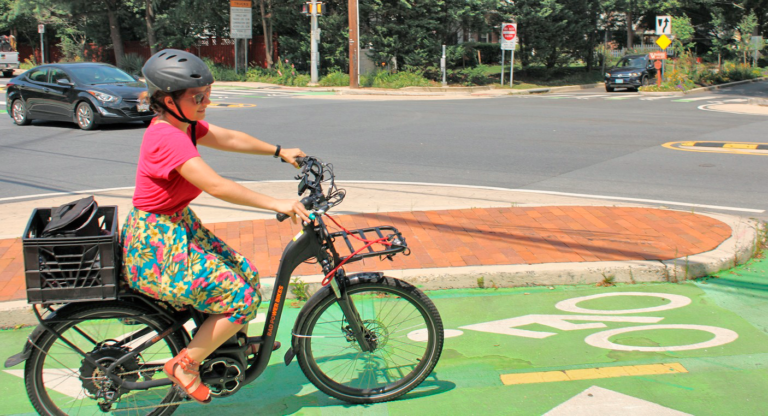
3. Double down on BUILDING a connected network of AAA bikeways
This one is simple: e-bikes are contributing to a surge in biking. With more vulnerable road users on our streets and demand for biking coming from a broader cross-section of society, the need for wide, All Ages and Abilities (AAA) facilities and separated bike lanes is more important than ever. In cities around the world, crowding on trails and in bikeways is a growing challenge, and the speed differential between users is amplifying the need for wider facilities. Perhaps the most powerful move cities can make is to rewrite their street and trail design manuals to establish AAA bikeways as the norm on major streets and to ensure shared use path/trail standards deliver generous trails that serve a wide range of users.
4. Promote e-bike incentive programs
To support transportation equity, we need to make sure e-bikes are accessible to all populations. That means setting up (and maintaining) rebate programs or other financial incentives to support the purchase of e-bikes, and then marketing those programs in priority communities. A well-known example is Denver’s e-bike voucher program, which has led to 100,000 vehicle miles traveled shifting to e-bikes from cars and the average user replacing 3-4 car trips per week. (Denver’s 2023 voucher program sold out in 20 minutes, despite being backed by a roughly $3M/year operating budget.)
It is also important to remember that, while the price tag of an e-bike can be significantly steeper than that of an entry-level bike, it is significantly less than the cost of an entry-level car. Incorporating a strong equity focus in your rebate/incentive program is essential. For example, Denver’s program offers $1,200 to income-qualified applicants (compared to their standard rebate of $300), and programs in other places like Vermont and Portland are entirely focused on income-qualified applicants. To get ideas on how to structure your program, check out Ride Review’s amazing compendium of e-bike subsidies, rebates, and incentives.
To support transportation equity, we need to make sure e-bikes are accessible to all populations.
5. Consider Parking and Charging Needs
Focus not only on e-bike trips, but also on the end of the trip. This starts by simply installing more conventional bike parking (short- and long-term), but we also must account for the larger size and weight of e-bikes. For instance, interior bike storage needs to be roll-up (not lift-up). We should also work toward universal charging opportunities in the public right-of-way — consider requiring a minimum amount of e-bike charging infrastructure when implementing other electrification projects (a dig-once approach), or updating building codes to require electric outlets near interior bike parking.
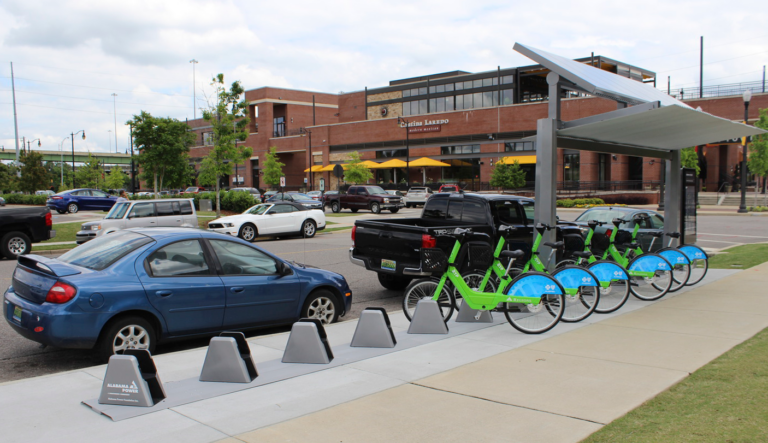
6. Focus on shared Fleets
Invest in bikeshare and shared micromobility, and incorporate e-bikes and e-scooters into those systems. Support or launch programs to facilitate e-cargo bike use for delivery companies. Consider an e-bike fleet to supplement or replace some City vehicles. Check out this cool program from Dublin, Ireland, or read about New York’s attempt to support delivery workers using e-bikes.
7. Educate Community Members and Elected Officials
Take every opportunity to build comfort around e-bikes with the public and with elected officials. Messaging campaigns and in-school curricula can improve safety and courtesy among potential e-bike riders. Such campaigns can also bolster support for e-bikes in general, even among motorists, as a way to reduce traffic congestion. In Orange County, CA, for example, we developed a campaign to get the word out about e-bike safety among young riders, including eye-catching bike hangers and a video with a TikTok influencer (and his friend Cheetah).
Getting elected leaders involved by organizing a group ride or providing fact sheets and talking points can help them use their platform to advocate for e-bikes (or preempt them from elevating reactive, onerous policies if they get complaints about e-bikes). It may also help get e-bike considerations into other adopted plans related to climate or public health.
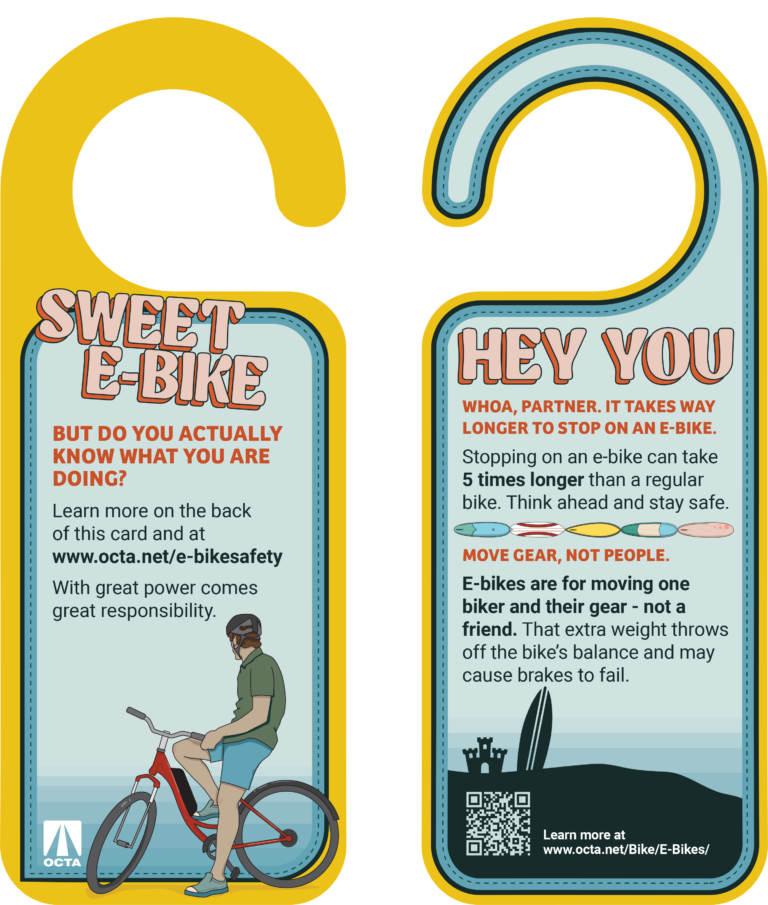
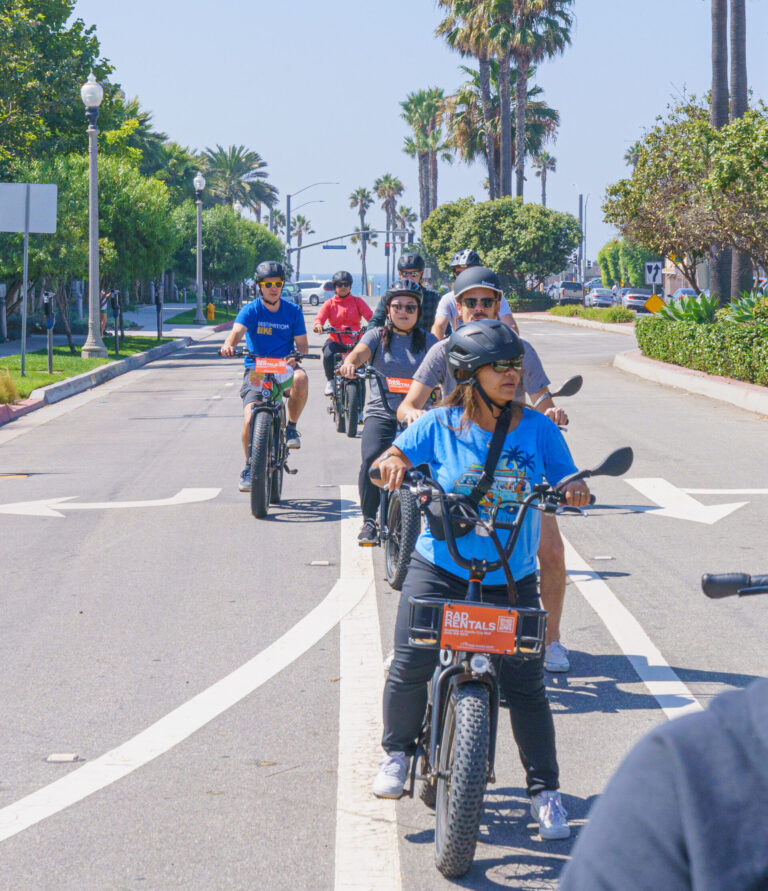
8. Set battery standards
We need to work toward regulation and standardization of e-bike batteries to prevent tragic explosions and fires. In December 2022, the Consumer Product Safety Commission called on manufacturers, importers, and retailers to voluntarily adhere to UL safety standards. States and cities can pass their own laws (like this example from CA or this one from New York). In addition to requiring UL-certified batteries, cities can support buy-back or trade-in programs for faulty or outdated e-bikes.
People in communities throughout the United States and Canada are embracing e-bikes, and we expect that trend to continue and intensify. As we, too, embrace the transformative potential of e-bikes, we can be ready for the challenges that arise by taking a holistic approach to transportation planning and making thoughtful, forward-thinking choices. Our e-bike projects include helping to develop policies, incentive programs, education/safety campaigns, design guidelines, and plans. Toole Design is ready for the e-bike revolution, and we’re here to help you.
